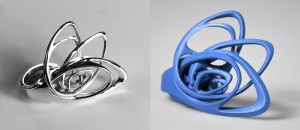Stratasys Collaborates on Jewelry Line

Latest News
September 15, 2014
 Designer Jenny Wu used 3D printing to create the cast for this ring, which was auctioned for $900. Image: Jenny Wu
Designer Jenny Wu used 3D printing to create the cast for this ring, which was auctioned for $900. Image: Jenny WuJewelry design and production is an important application for 3D printing, and plenty of established companies and hobbyists have used the technology create finished pieces, prototypes, and casts. Now Stratasys has teamed up with an award-winning designer to create high-end jewelry. The company has announced a collaboration with designer Jenny Wu on a 3D-printed jewelry collection called LACE.
LACE includes a number of 3D printed designs, including necklaces and rings that the company says were inspired by “line-based geometry and intricate, organic movement, standing out as a bold statement on the body.”
Wu, also an architect and lecturer, and her partner/husband Dwayne Oyler operate the Oyler Wu Collaborative fabrication firm.
“I wanted to design a range of jewelry that could be avant-garde yet wearable, and approached it from my architectural heritage of spatial and line-based geometries to form a bold but soft spectacle for the body,”Wu said. “From my 15 years’ experience with 3D printing for architectural projects, I knew it would deliver the capabilities to realize my creative vision for jewelry. 3D printing offers an elegant aesthetic and enables different layers and densities of fine and detailed pieces to be intertwined and produced within hours instead of months.”
The Tangens necklace, available in black, white and translucent, was created on a Stratasys Fortus 400mc production system. Wu worked with Stratasys subsidiary Solidscape to make the Papilio ring using the MAX2 printer an da lost wax investment casting process. The ring was part of an auction at Paddle8 last month, and sold for $900.
“I enjoy the possibilities that FDM offers, as it enables me to directly manufacture jewelry pieces as opposed to just prototype,” Wu said. “After some experimentation, I found that the ABS-M30 in particular was the best 3D printing material for Tangens. Its ability to execute accurate complex geometry with striations from the layering process gives the necklace a unique velvety quality, as well as a robust, thick structure, which results in a wearable item that is elegant, yet durable.”
The collection will be available for sale this fall. You can read more about the line on Wu’s blog.
Source: Stratasys
Subscribe to our FREE magazine, FREE email newsletters or both!
Latest News
About the Author
Brian Albright is the editorial director of Digital Engineering. Contact him at [email protected].
Follow DE





